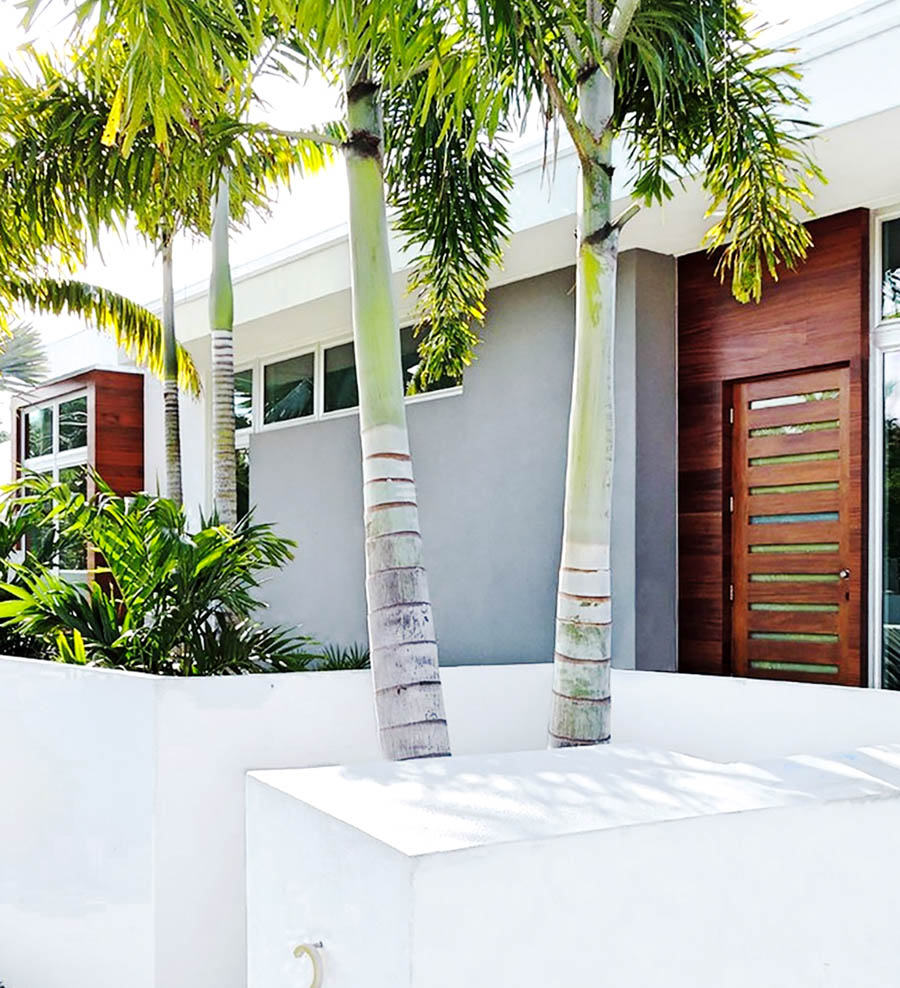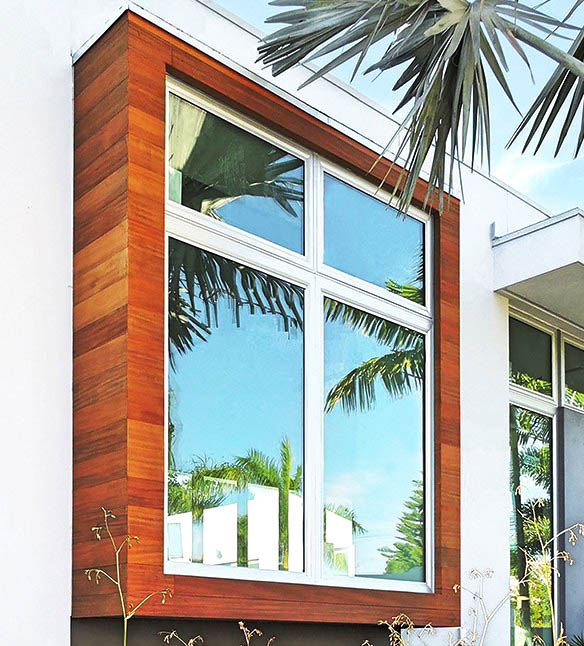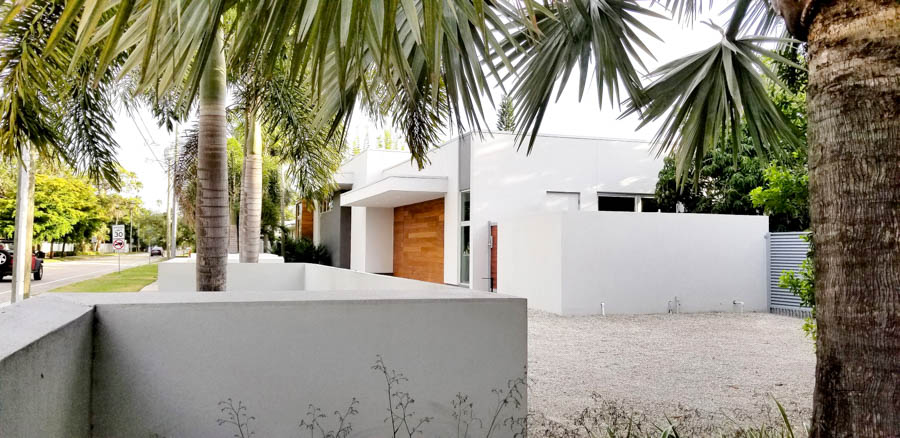“I’ve worked with a lot of architects over the years and there are a few I’m excited to work with time and time again,” says Grant Castilow. “Leo definitely falls into that category.” Castilow is a general contractor and the president of Vertical Design + Build, a custom home building firm. He’s talking about Leonardo Lunardi, the principal architect of Lunardi Architecture. Both men are based in Sarasota and have worked on a handful of projects together over the years. One of their earliest collaborations was a California contemporary style home in Southside Village that finished construction in 2014. Ten years later, Castilow and Lunardi sit down and revisit this project through the lens of time. “The clients for this project were a husband and wife,” Castilow recalls. “He was a doctor, so the location appealed to him because it was so close to Sarasota Memorial Hospital.”
The location in question was a lot in Southside
Village, a mixed residential and commercial neighborhood located a mile south of downtown Sarasota. Popular with families and young professionals alike, the neighborhood is known for its green spaces and walkability. The streets are lined with mature trees that cast their shade over a diverse array of housing options including historic bungalows, Mediterranean-inspired villas, modern architecture, and single-family homes that have been built over the past several decades. Quiet residential streets soon give way into a flourishing shopping district largely centered around the intersection of Hillview Street and Osprey Avenue. This lively business hub is teeming with shops, from high-end galleries to trendy boutiques to beloved local eateries.
The aesthetics and amenities of Southside Village make it a desirable place to live, and that was true back in 2014 as well. Properties were hard to come by, and the one that the clients had purchased was not one that would be easy to work with. The lot was pie-shaped, which means it was narrower in the front and wider in back. Irregularly-shaped lots like these can be difficult to design for, especially if your clients have particular needs.
“Privacy was a big concern for these clients,” Lunardi says. “They wanted a serene outdoor space they could enjoy, and they wanted it to feel secluded.”
That was easier said than done. At just over a quarter acre in size, the lot wasn’t exactly small but it wasn’t particularly spacious either. It would be difficult to foster a sense of solitude and separation with neighboring properties snugly tucked against each side of the property line. The lot was also located near the boundary where the quiet residential neighborhood gave way into the hustle and bustle of the commercial district. The property was just a few hundred feet away from the iconic local gourmet grocery store Morton’s Market. On the one hand, delicious snacks would only be a short walk away. On the other hand, the frequent comings and goings of customers would quickly ruin the illusion of a remote retreat in the backyard.
Ultimately, Lunardi spelled out a solution by designing what was essentially a U-shaped house. The bottom of the U would face the main road, while the legs of the U would extend toward the backyard, creating a space for a semi-enclosed private courtyard behind the house. The only thing that kept the house from being a true U-shape was the addition of an attached garage on one side. With the design completed, the project began moving forward at a fast clip.

“I remember being on a tight timeline,” Castilow says. “I think they wanted to be in the house for the holidays.”
“Was it a wedding?” Lunardi interjects.
“Yes!” Castilow says. “That was it. We absolutely had to be done in December because there was a family wedding.”
“I think they were also very firm on the budget,” Lunardi says.
“That’s right. What’s that saying? You can have it done, fast, good, or cheap, but you can only pick two,” Castilo says. “Obviously I’m always going to do a good job, so usually the compromise has to come on timeline or budget.”
“But this time there was no compromise,” Lunardi concludes.
Because it had been so long since they had worked on the project, Castilow and Lunardi pulled out old plans, pictures, and documents to refresh their memories. Castilow made an unexpected discovery along the way.
“According to this, the city approved the permits in February of 2014 and we wrapped up the project in December of 2014,” he says. “Can you believe that?”
“There’s absolutely no way you could do it that quickly now,” Lunardi agrees.
The Southside Village home is an example of California contemporary architecture, a style that began to emerge in the mid-20th century. California contemporary design is characterized by clean lines, innovative construction techniques, and an emphasis on sustainability. Homes designed in this style often feature open floor plans and indoor-outdoor living areas and utilize natural materials like glass, wood, and stone, details which can all be found in this home. While an increasing number of contemporary homes have been built in the Southside Village neighborhood over the past ten years, this was one of the earlier examples.
“When you look at this house through the lens of what’s going on today, it has the elements you’d expect from a contemporary house. But Leo was really ahead of his time,” Castilow says. “A lot of the things he did here were not things people were doing back then, like the recessed lighting bars in the living room or the accordion glass doors that lead out to the courtyard. Now you can get things like that from multiple suppliers, but back then you could maybe get them from one vendor or you had to get them custom made.”
Contemporary architecture often utilizes geometric forms, whether it’s in the form of straight lines and rectilinear shapes or curves and organic silhouettes. The Southside Village house takes the former approach.
“I was looking at the plan and you put a lot of corners in here,” says Castilow. “I think I counted 41.”

“You must have only counted the ones outside,” says Lunardi.
“Because there were a lot more than that.” But while the house is quite angular, there’s a sense of movement and ease to it that is palpable even in photographs. The already-spacious indoor living area becomes even more expansive when the glass doors are folded away to create a seamless transition out into outdoor space. When you step into the courtyard, you see it is bordered on both sides by the stems of the U-shape. The left side holds a master bedroom suite, while the right side features office space. The massive sliding glass doors on either side contribute to the feeling of openness, ensuring the courtyard is private without being penned in.
Inside the house, you’ll find large windows in nearly every room. The one exception is the kitchen, which loses its one exterior wall to the attached garage. It still gets ample natural light though, thanks to clever design choices. The wall that separates the kitchen from the foyer doesn’t go all the way to the ceiling, which allows light to filter in from the clerestory windows in the living room. “Skylights have kind of a bad reputation, but I like using them to bring light into a room,” Lunardi says. “The quality of them is much better than they used to be.” Here, the skylights beam sunlight onto dual dichroic pendant light fixtures which adds an interesting and ever-changing visual element to the space.
Lunardi’s favorite detail, though, is on the exterior of the home. “One thing I really pushed Grant for was to do the cantilever in the front of the house,” Lunardi says. “Do you see when you look at the garage, how it looks like the building is almost floating above the ground?”
“That was our biggest conflict on the project,” says Castilow. “I thought you were crazy.”
“I still can’t believe you actually went for it,” Lunardi admits. “I don’t know how I convinced you.”
“You wanted to do it all the way around the house but you’ll notice I put my foot down,” Castilow says.
“That’s okay,” Lunardi says. “I got my way in the place where it was most important.” At the end of the day, what is their biggest takeaway from this trip down memory lane? “Looking back, I’m actually really happy about how this design has held up over time,” Lunardi says. “I’d love to look back on it in another fifteen years to see if it still feels this timeless.” Castilow adds, “I’m realizing that I’d really like to work with Leo again. It’s been too long. But no cantilevering this time.”










